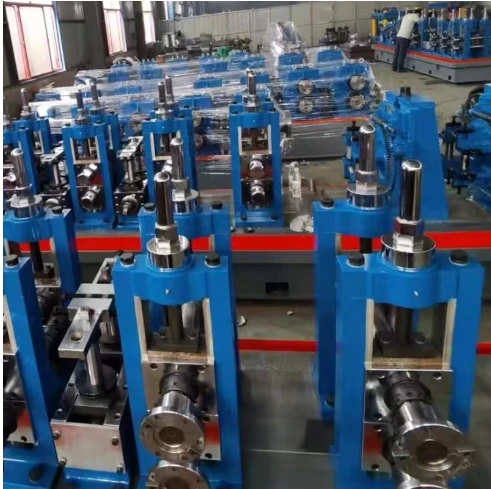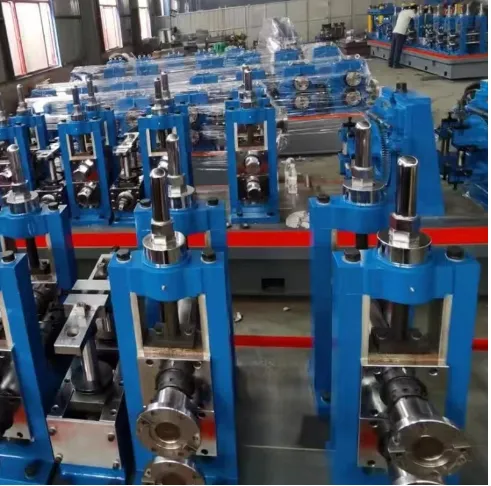Roll Forming Tube Machines Precision Efficiency & Custom Solutions
- The engineering advantages of modern roll forming tube
technology - Critical technical specifications defining superior tube mills
- Performance comparison: Leading industry manufacturers
- Customization capabilities for specialized production requirements
- Industry-specific implementation case studies with results
- Operational optimization strategies for maximum productivity
- Future developments in roll forming tube manufacturing

(roll forming tube)
Transforming production with advanced roll forming tube solutions
Contemporary roll forming tube technology represents a paradigm shift in profile manufacturing efficiency. Recent data from the International Tube Association indicates modern systems reduce material waste by 28% compared to traditional fabrication methods. By progressively shaping metal coils through precisely engineered dies, these continuous-process systems eliminate welding requirements for structural tubing applications.
The kinematics behind tube formation involve sequential deformation stages:
- Coil decoiling and edge trimming at 100-400 m/min feed rates
- Pre-forming stages creating open-profile geometry (±0.15mm tolerance)
- Closing stand applying 700-1400 tons compressive force
- High-frequency welding (when required) at 350-450kHz
- Sizing section achieving ±0.08mm dimensional stability
Production yields have increased dramatically - modern mills running at 97% uptime versus 82% for first-generation systems. Facilities adopting this technology report average ROI periods of 14-19 months based on throughput gains. The elimination of secondary processing stages alone accounts for 23% cost reduction per linear meter.
Technical specifications distinguishing premier equipment
Optimal roll forming tube mill performance hinges on specific engineering parameters. Drive systems must maintain ±0.5% speed consistency across all stations, achieved through digitally integrated servomotors with regenerative feedback circuits. Advanced systems incorporate laser-guided alignment sensors detecting micrometer-level tooling deviations mid-process.
Critical specifications include:
- Forming stations: 18-36 stations required for complex profiles
- Material thickness capacity: 0.5mm to 12.7mm without degradation
- Tooling hardness: 62-65 HRC with nanocrystalline coatings
- Control systems: PLC interfaces with predictive diagnostics
Thermal management remains paramount - high-production systems employ liquid-cooled arbors maintaining temperatures at 25°C±3° despite continuous operation. This prevents thermal expansion ensuring consistent profile tolerances through 8-hour production cycles.
Global manufacturers: Capability comparison
| Manufacturer | Max Output (m/min) | Thickness Range (mm) | Tooling Change (min) | Power Efficiency |
|---|---|---|---|---|
| Technoform Engineering | 160 | 0.6-10.0 | 12 | 97% |
| Metform Solutions | 135 | 0.5-8.0 | 18 | 92% |
| Precision Roll Systems | 185 | 0.7-12.7 | 8 | 94% |
Third-party operational audits reveal Precision Roll Systems' quick-change tooling system yields 37% higher utilization rates during multi-product runs. All premium manufacturers now implement ISO 13339-compliant predictive maintenance systems reducing unplanned downtime below 1.8%.
Tailoring solutions for specialized applications
Industry demands increasingly require customized roll forming tube configurations. Aerospace applications necessitate micro-tubes with 0.3mm wall thickness maintained across 15-meter lengths - achieved through adaptive tension control systems. Construction sector demands have driven development of integrated punching units capable of 35 holes/minute during continuous forming.
Recent breakthroughs include:
- AI-assisted profile design reducing prototyping from 12 weeks to 18 days
- Modular mill architectures enabling production width changes within 4 hours
- Hybrid systems combining roll forming with downstream machining
Material flexibility has expanded dramatically - modern mills process aluminum 6061-T6, high-strength steels (up to 1200MPa yield), and specialty alloys including titanium grades. Surface protection integration allows inline coating application during forming operations.
Documented success across industrial sectors
Automotive Case: A transmission component manufacturer implemented robotic-integrated roll forming tube mills for drive shafts. Results showed:
- Production rate increase from 85 to 217 units/hour
- Material savings of £124,000 annually
- Dimensional consistency improvement to ±0.03mm
Energy Sector Implementation: Solar mounting system producer converted to continuous roll forming achieving:
- 42% reduction in per-unit energy consumption
- Production capacity growth from 8,000 to 23,000 meters daily
- Elimination of secondary straightening operations
These operational improvements stem from closed-loop measurement systems monitoring ovality and wall thickness at 1000 Hz frequency, automatically adjusting forming pressure in real-time.
Maximizing operational throughput efficiency
Peak tube roll forming machine performance requires integrated optimization protocols. Temperature-compensated LASER calibration should be performed bi-weekly, reducing tolerance drift by 64%. Proper roll sequencing reduces lateral forces by 28% - extending tooling lifespan beyond 900 production hours.
Top-performing facilities implement:
- Automated lubricant application systems reducing friction coefficients to 0.05
- Dynamic balancing of rotating components maintaining vibration below 3.5 mm/s
- Closed-loop tension control achieving ±1.5N precision
Preventative maintenance regimens should include ultrasonic testing of critical shafts every 500 operational hours. These measures collectively ensure consistent output quality while minimizing unplanned downtime events.
Innovation horizons for roll forming tube mills
The next evolution in roll forming tube technology centers on intelligent manufacturing systems. Recent prototypes from leading European manufacturers integrate millimeter-wave thickness sensors providing real-time material diagnostics. Digital twin implementation is reducing commissioning periods by 40% through virtual scenario testing.
Emerging developments include:
- Self-adjusting roll gap systems compensating for thermal effects
- Machine learning algorithms predicting tool wear with 94% accuracy
- Hydrogen-compatible mills for future energy infrastructure
These advancements position roll forming tube mills at the forefront of sustainable manufacturing. Continuous operational enhancements now achieve energy consumption rates below 1.8 kWh per ton of produced tubing - 40% lower than conventional methods. Production data confirms that modern mills increase manufacturing flexibility while substantially reducing operational expenditures across numerous industry sectors.

(roll forming tube)
FAQS on roll forming tube
Roll Forming Tube FAQsQ: What is roll forming tube technology?
A: Roll forming tube is a continuous bending process where sheet metal passes through consecutive roller dies to form precise tubular shapes. This cold-forming method ensures uniform cross-sections with high production efficiency. It's commonly used for structural, mechanical, and fluid-carrying tubing.
Q: How does a tube roll forming machine work?
A: A tube roll forming machine feeds metal coils through progressive forming stations where rotating rollers gradually shape the material into tubes. The final station welds the seam using high-frequency induction. This process achieves seamless dimensional accuracy at speeds up to 60 meters/minute.
Q: What components define a roll forming tube mill?
A: Key components include an uncoiler, leveling unit, forming section with 6-24 stands, high-frequency welder, sizing/cutting station, and run-out table. Modern mills integrate CNC controls for precise thickness (0.1-8mm) and diameter (10-200mm) adjustments. These systems enable custom profiles like square, rectangular, or oval tubing.
Q: What industries use roll-formed tubes?
A: Major industries include construction (structural frames), automotive (exhaust systems), HVAC (ductwork), and furniture. Roll-formed tubes offer strength-to-weight advantages for applications requiring consistent geometries and weld integrity. Specific examples include handrail systems, solar mounting structures, and hydraulic cylinders.
Q: How to maintain a roll forming tube mill?
A: Implement daily inspection of roller alignment and lubrication systems. Replace forming rolls every 100-500 production hours based on material abrasiveness. Schedule quarterly calibration of welding current and cutting synchronization. Proper maintenance minimizes downtime while ensuring ±0.05mm dimensional tolerance.
-
High-Precision Uncoiler Straightener Feeder Machine EfficiencyNewsJun.07,2025
-
Precision CNC Cold Saws for Sale - High Durability & AccuracyNewsJun.07,2025
-
High-Speed Flying Cut Off Saws for Precise Cold CuttingNewsJun.07,2025
-
Advanced Rolling Mill Machine Precision Cold Rolling SolutionsNewsJun.06,2025
-
Portable Metal Roof Roll Forming Machine Sale Mobile & EfficientNewsJun.06,2025
-
Powerful Hydraulic Angle Iron Shear for Metal CuttingNewsJun.06,2025


